Inde: GLAQ prévient le déficit de mémoire induit par l'hypoxie hypobare
Juin 2, 2020/Institut de Physiologie de la Défense& Sciences alliées(Inde)/Rapports scientifiques
Texte/Wu Tingyao
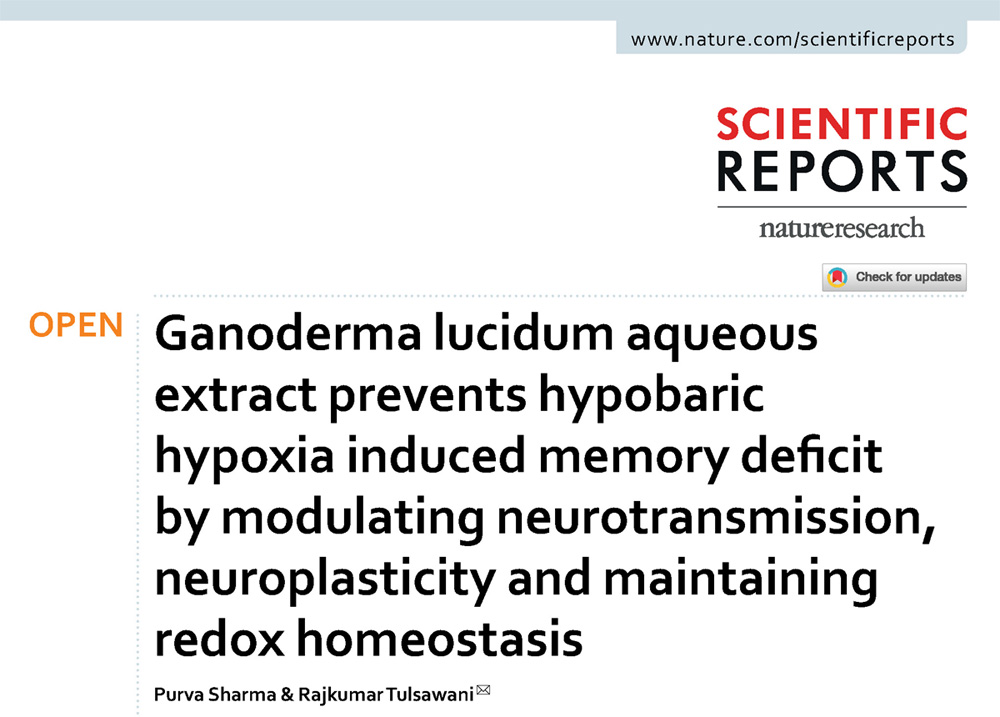
Plus l'altitude est élevée, plus la pression de l'air est basse, plus l'oxygène est dilué, plus le fonctionnement des fonctions physiologiques est affecté, plus il est susceptible d'entraîner divers risques pour la santé communément appelés mal d'altitude.
Ces risques pour la santé peuvent n’être que des maux de tête, vertiges, nausée, vomissement, fatigue et autres inconforts, et ils peuvent également évoluer vers un œdème cérébral qui affecte la cognition, moteur, et fonctions de conscience, ou œdème pulmonaire qui affecte la fonction respiratoire. Quelle est la gravité de la situation? La capacité des cellules tissulaires du corps à s'adapter aux changements de concentration externe en oxygène dépend de la capacité des cellules tissulaires du corps à s'adapter aux changements de concentration externe en oxygène..
La survenue et la gravité du mal de l'altitude varient d'une personne à l'autre., et cela dépend surtout de la forme physique de l’individu.. En principe, altitudes au-dessus 1,500 mètres (moyenne altitude) commencera à affecter le corps humain; toute personne, y compris les adultes en bonne santé, qui atteint imprudemment une altitude de 2,500 mètres ou plus (haute altitude) avant que le corps ne s'adapte, il est sujet aux problèmes.
Qu'il s'agisse d'une planification minutieuse des hauteurs d'escalade ou de la prise de médicaments préventifs avant le départ, le but est d’améliorer la capacité d’adaptation du corps et de prévenir l’apparition du mal d’altitude. Mais en fait, il y a une autre option, ça prendGanoderma lucidum.
Selon une étude publiée par l'Institut de physiologie et sciences connexes de la Défense (haleine) en juin 2020 dans les rapports scientifiques, il a été constaté que Ganoderma lucidum extrait aqueux (GLAQ) peut réduire les dommages de l'hypoxie hypobare aux nerfs crâniens et maintenir les fonctions cognitives liées à la mémoire spatiale.
Labyrinthe– Une bonne façon de tester la capacité de mémoire des rats
Avant le début de l'expérience, Les chercheurs ont passé quelques jours à s'entraîner aux rats pour trouver une plate-forme cachée immergée juste en dessous de la surface de l'eau. (Chiffre 1).
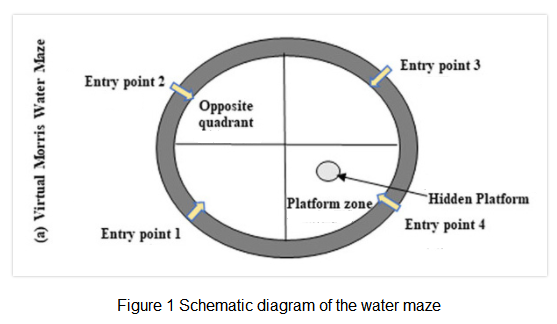
Les rats sont bons à nager, Mais ils n'aiment pas l'eau, Alors ils essaieront de trouver un endroit pour éviter l'eau.
Selon le dossier de trajectoire de natation sur la figure 2, On peut constater que les rats ont trouvé la plate-forme de plus en plus rapidement de se déplacer plusieurs fois le premier jour à la ligne droite le sixième jour (troisième droit en figure 2), montrant qu'il a une bonne capacité de mémoire spatiale.
Une fois la plate-forme supprimée, le parcours de nage du rat concentré dans la zone où se trouvait la plateforme (la première droite sur la figure 2), indiquant que le rat avait une mémoire claire de l'endroit où se trouvait la plate-forme.
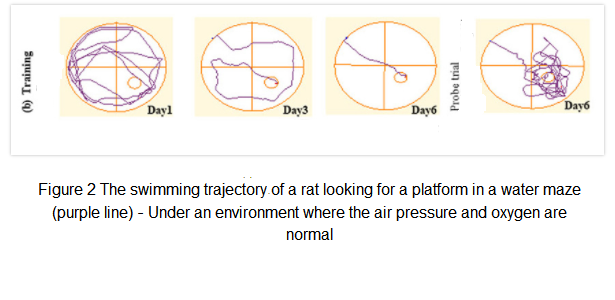
Ganoderma lucidum atténue les effets de l'hypoxie hypobare sur la mémoire spatiale
Ces rats normaux entraînés ont été divisés en deux groupes. Un groupe a continué à vivre dans un environnement avec une pression atmosphérique et de l'oxygène normaux comme groupe témoin. (Contrôle) tandis que l'autre groupe a été envoyé dans une chambre à basse pression pour simuler une vie à une altitude ultra-élevée de 25,000 pieds ou environ 7620 mètres dans un environnement d'hypoxie hypobare (HH).
Pour les rats envoyés en chambre basse pression, une partie d'entre eux a été nourrie avec un extrait aqueux deGanoderma lucidum (GLAQ) à une dose quotidienne de 100, 200, ou 400 mg/kg (HH+GLAQ 100, 200, ou 400) tandis que l'autre partie d'entre eux n'était pas nourrie avecGanoderma lucidum (Groupe HH) comme groupe témoin.
Cette expérience a duré une semaine. Le lendemain de la fin de l'expérience, les cinq groupes de rats ont été placés dans le labyrinthe aquatique pour voir s'ils se souvenaient de la position de la plate-forme. Le résultat a été montré dans la figure 3:
Le groupe témoin (Contrôle) Je me souvenais toujours clairement de l'emplacement de la plate-forme et je pouvais la trouver immédiatement; la capacité de mémoire des rats de chambre à basse pression (HH) était considérablement altéré, et leur temps pour trouver la plate-forme était plus de deux fois supérieur à celui du groupe témoin. Mais aussi vivre dans l’environnement pauvre en oxygène de la chambre basse pression, les rats qui ont mangé le GLAQ avaient une mémoire nettement meilleure de la plateforme, et plusGanoderma lucidum ils ont mangé, le temps passé était plus proche de celui du groupe témoin normal.
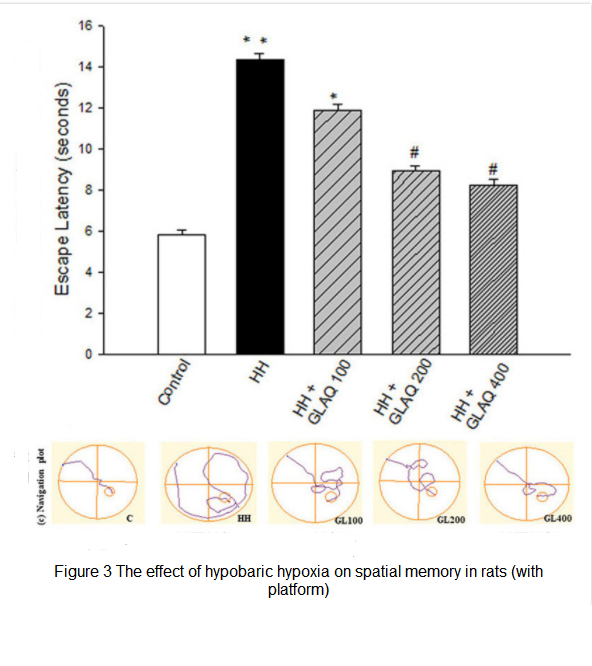
Ganoderma lucidum atténue les effets de l'hypoxie hypobare sur la mémoire spatiale
Ces rats normaux entraînés ont été divisés en deux groupes. Un groupe a continué à vivre dans un environnement avec une pression atmosphérique et de l'oxygène normaux comme groupe témoin. (Contrôle) tandis que l'autre groupe a été envoyé dans une chambre à basse pression pour simuler une vie à une altitude ultra-élevée de 25,000 pieds ou environ 7620 mètres dans un environnement d'hypoxie hypobare (HH).
Pour les rats envoyés en chambre basse pression, une partie d'entre eux a été nourrie avec un extrait aqueux deGanoderma lucidum (GLAQ) à une dose quotidienne de 100, 200, ou 400 mg/kg (HH+GLAQ 100, 200, ou 400) tandis que l'autre partie d'entre eux n'était pas nourrie avecGanoderma lucidum (Groupe HH) comme groupe témoin.
Cette expérience a duré une semaine. Le lendemain de la fin de l'expérience, les cinq groupes de rats ont été placés dans le labyrinthe aquatique pour voir s'ils se souvenaient de la position de la plate-forme. Le résultat a été montré dans la figure 3:
Le groupe témoin (Contrôle) Je me souvenais toujours clairement de l'emplacement de la plate-forme et je pouvais la trouver immédiatement; la capacité de mémoire des rats de chambre à basse pression (HH) était considérablement altéré, et leur temps pour trouver la plate-forme était plus de deux fois supérieur à celui du groupe témoin. Mais aussi vivre dans l’environnement pauvre en oxygène de la chambre basse pression, les rats qui ont mangé le GLAQ avaient une mémoire nettement meilleure de la plateforme, et plusGanoderma lucidum ils ont mangé, le temps passé était plus proche de celui du groupe témoin normal.
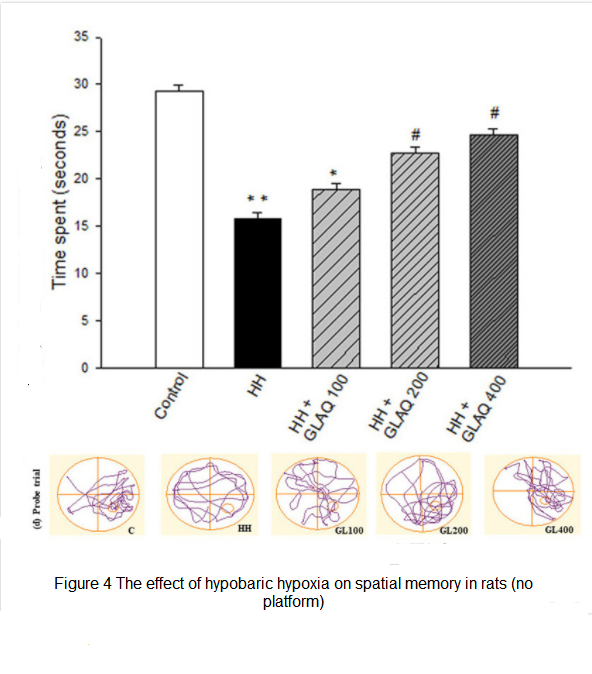
Ganoderma lucidum protège le cerveau et réduit l'œdème cérébral et les dommages au gyrus de l'hippocampe.
Les résultats expérimentaux ci-dessus montrent queGanoderma lucidum peut en effet atténuer le trouble de la mémoire spatiale provoqué par l'hypoxie hypobare. La fonction de mémoire est une manifestation du caractère normal de la structure et du fonctionnement du cerveau.. Donc, les chercheurs ont ensuite disséqué et analysé les tissus cérébraux des rats expérimentaux, et j'ai trouvé que:
L'hypoxie hypobare peut provoquer un angio-œdème (la perméabilité accrue des capillaires permet à une grande quantité de liquide de s'échapper des vaisseaux sanguins et de s'accumuler dans les espaces interstitiels du cerveau) et gyrus hippocampique (responsable de la formation de la mémoire) dommage, mais ces problèmes sont beaucoup soulagés sur les rats qui ont été nourris au préalable avec du GLAQ (Chiffre 5 et 6), indiquant queGanoderma lucidum a pour effet de protéger le cerveau.
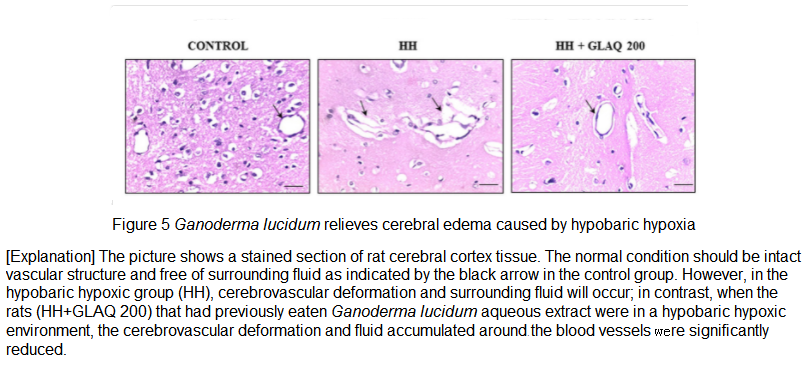
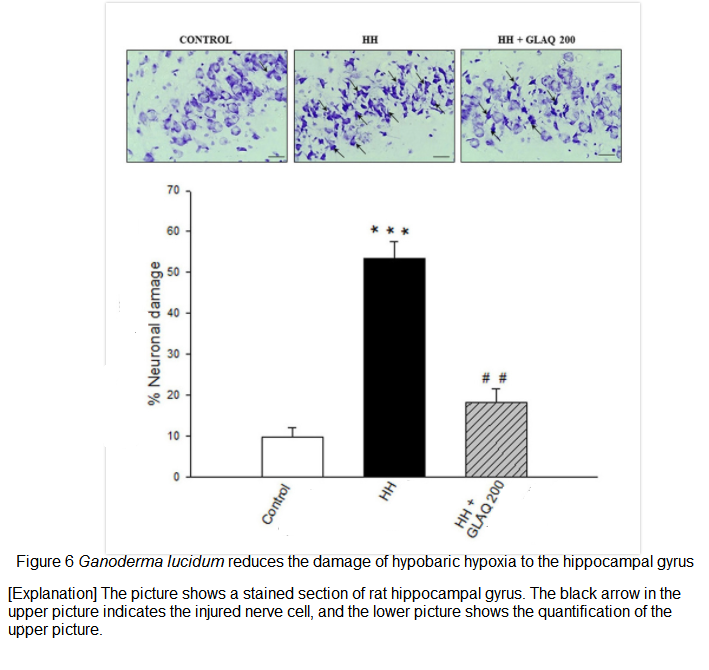
Le mécanisme deGanoderma lucidum contre l'hypoxie hypobare
Pourquoi leGanoderma lucidum l'extrait aqueux peut résister aux dommages causés par l'hypoxie hypobare? Les résultats d'une discussion plus approfondie sont résumés dans la figure 7. Il existe essentiellement deux directions générales:
D'une part, la réponse physiologique du corps lors de l’adaptation à l’hypoxie hypobare sera ajustée plus rapidement et mieux grâce à l’intervention deGanoderma lucidum; d'autre part, Ganoderma lucidum peut réguler directement les molécules associées dans les cellules nerveuses du cerveau par anti-oxydation et anti-inflammation, maintenir un oxygène constant dans le corps, ajuster les circuits neuronaux du cerveau, et maintenir une transmission nerveuse fluide afin de protéger le tissu nerveux et la capacité de mémoire.
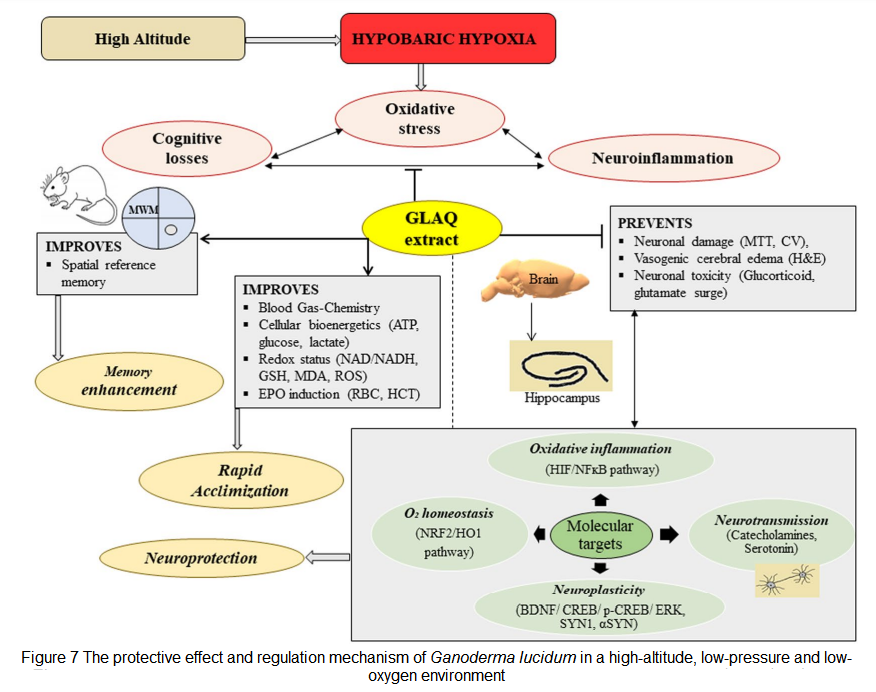
Dans le passé, de nombreuses études ont souligné queGanoderma lucidum peut protéger les nerfs cérébraux contre divers aspects tels que la maladie d’Alzheimer, La maladie de Parkinson, épilepsie, embolie vasculaire, lésion cérébrale accidentelle, et le vieillissement. Maintenant, cette recherche en Inde ajoute une autre preuve deGanoderma lucidum« améliorer la sagesse et la mémoire » du point de vue de la haute altitude, basse pression et faible teneur en oxygène.
En particulier, l'unité de recherche Institut de Physiologie de la Défense& Sciences alliées (haleine) est affilié à l'Organisation de recherche et de développement de la Défense nationale (DRDO) du ministère indien de la Défense. Il mène depuis longtemps des explorations approfondies dans le domaine de la physiologie de la haute altitude.. La manière d’améliorer l’adaptabilité et l’efficacité au combat des soldats face aux environnements et aux pressions de haute altitude a toujours été au centre de son attention.. Cela rend les résultats de cette recherche plus significatifs.
Les principes actifs contenus dans leGanoderma lucidum l'extrait aqueux GLAQ utilisé dans cette étude comprend des polysaccharides, phénols, flavonoïdes, et acide ganodérique A. Avant de publier cette étude, le chercheur a effectué un test de toxicité subchronique de l'extrait pendant 90 jours et a confirmé que même si sa dose est aussi élevée que 1000 mg/kg, cela n'aura pas d'impact négatif sur les tissus, organes et croissance des rats. Donc, la dose minimale efficace de 200 mg/kg dans l'expérience ci-dessus est évidemment sans danger.
Ce n'est que lorsque vous êtes parfaitement préparé que vous pourrez profiter du plaisir de l'escalade et ressentir le contact d'être proche de l'horizon.. Si vous avez un coffre-fortGanoderma lucidum pour te remonter le moral, vous devriez pouvoir réaliser vos souhaits de manière plus sûre.
[Source]
1. Purva Sharma, Rajkumar Tulsawani. Ganoderma lucidum l'extrait aqueux prévient le déficit de mémoire induit par l'hypoxie hypobare en modulant la neurotransmission, neuroplasticité et maintien de l'homéostasie redox. Représentant scientifique. 2020; 10: 8944. Publié en ligne 2020 juin 2.
2. Purva Sharma, et autres. Effets pharmacologiques de Ganoderma lucidum extrait contre les facteurs de stress de haute altitude et son évaluation de la toxicité subchronique. J Food Biochimie. 2019 Déc;43(12):e13081.
FIN
À propos de l'auteur/Mme. Wu Tingyao
Wu Tingyao rapporte des informations de première main sur le Ganoderma depuis 1999. Elle est l'auteur deGuérir avec Ganoderma (publié dans The People's Medical Publishing House en avril 2017).
★ Cet article est publié sous l'autorisation exclusive de l'auteur.
★ Les œuvres ci-dessus ne peuvent pas être reproduites, extrait ou utilisé d’une autre manière sans l’autorisation de l’auteur.
★ Pour les violations de la déclaration ci-dessus, l'auteur assumera les responsabilités juridiques pertinentes.
★ Le texte original de cet article a été rédigé en chinois par Wu Tingyao et traduit en anglais par Alfred Liu.. S'il y a une divergence entre la traduction (Anglais) et l'original (Chinois), le chinois original prévaudra. Si les lecteurs ont des questions, veuillez contacter l'auteur original, MS. Wu Tingyao.



